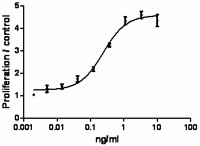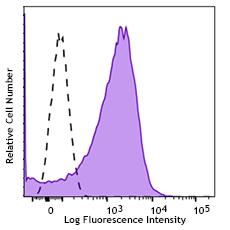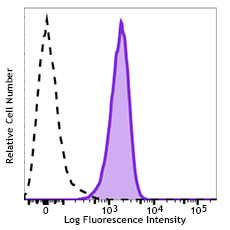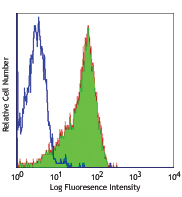- Regulatory Status
- RUO
- Other Names
- T-cell grow factor, TCGF
- Ave. Rating
- Submit a Review
- Product Citations
- publications

-

CTLL-2 proliferation induced by rat IL-2
Interleukin 2 was discovered through its function as a T cell growth factor (TCGF). IL-2 binds to IL-2 receptor which is expressed in T and B cells, thymocytes, and NK cells. The IL-2 receptor comprises three distinct components: the α-chain, which is cytokine specific, and the β- and γc-subunits which are share with the IL-15 receptor. In addition, the γc-subunit is a component of a series of other cytokine receptors, these being members of the γc cytokine receptor family (IL-4, IL-7, IL-9, and IL-21) (3). IL-2 signaling may play a major role in the differentiation of regulatory T cells (4). IL-2, IL-15, and IL-7 can all support NK cell differentiation; nevertheless, analyses of IL-2(-/-), IL-2Rα(-/-) mice fail to exhibit significant defects in NK cell development. This data suggest that IL-2 might have a redundant role in NK cell differentiation (4).
Product DetailsProduct Details
- Source
- Rat IL-2, amino acids Ala21-Met153 (Accession # NM_053836) was expressed in E. coli.
- Molecular Mass
- The 134 amino acid N-terminal methionylated recombinant protein has a predicted molecular mass of 15,396 Da. The DTT-reduced protein migrates at approximately 14kDa and the non-reduced protein migrates with slightly greater mobility by SDS-PAGE.
- Purity
- Purity is >98%, as determined by Coomassie stained SDS-PAGE.
- Formulation
- 0.22 µm filtered protein solution is in 5mM NaH2PO4, 5mM citric acid, 150mM NaCl, pH 4.0.
- Endotoxin Level
- Endotoxin level is <0.1 EU/µg (<0.01ng/µg) protein as determined by the LAL method.
- Concentration
- 10 and 25 µg sizes are bottled at 200 µg/mL. 100 µg size and larger sizes are lot-specific and bottled at the concentration indicated on the vial. To obtain lot-specific concentration and expiration, please enter the lot number in our Certificate of Analysis online tool.
- Storage & Handling
- Unopened vial can be stored between 2°C and 8°C for up to 2 weeks, at -20°C for up to six months, or at -70°C or colder until the expiration date. For maximum results, quick spin vial prior to opening. The protein can be aliquoted and stored at -20°C or colder. Stock solutions can also be prepared at 50 - 100 µg/mL in appropriate sterile buffer, carrier protein such as 0.2 - 1% BSA or HSA can be added when preparing the stock solution. Aliquots can be stored between 2°C and 8°C for up to one week and stored at -20°C or colder for up to 3 months. Avoid repeated freeze/thaw cycles.
- Activity
-
Assay 1. Recombinant Rat IL-2 induces the proliferation of mouse CTLL2 cells in a dose-dependent manner. The ED50 for this effect is 0.1 to 0.6 ng/mL.
Assay 2. Recombinant Rat IL-2 induces the proliferation of mouse HT-2 cells in a dose-dependent manner. The ED50 for this effect is 0.15 to 0.9 ng/mL. - Application
-
Bioassay
- Recommended Usage
-
Use when high specific biological activity is required.
- Application Notes
-
BioLegend carrier-free recombinant proteins provided in liquid format are shipped on blue-ice. Our comparison testing data indicates that when handled and stored as recommended, the liquid format has equal or better stability and shelf-life compared to commercially available lyophilized proteins after reconstitution. Our liquid proteins are verified in-house to maintain activity after shipping on blue ice and are backed by our 100% satisfaction guarantee. If you have any concerns, contact us at tech@biolegend.com.
- Application References
-
- Xiao X,. et al. 2012. J. Immunol. 188:892. PubMed.
- Product Citations
-
Antigen Details
- Structure
- cytokine
- Distribution
-
Activated T cells are the predominant source of IL-2 produced during immune responses
- Function
- IL-2 stimulates the proliferation of T cells, induces the generation of cytotoxic T lymphocytes (CTLs), facilitates the proliferation of and the synthesis of immunoglobulin by B cells, and induces the generation and persistence of natural killer (NK) cells. In addition, IL-2 signaling plays a major role in the differentiation of regulatory T cells.
- Ligand/Receptor
- IL-2R (α, β, γc)
- Cell Type
- Hematopoietic stem and progenitors, Embryonic Stem Cells
- Biology Area
- Cell Biology, Immunology, Stem Cells
- Molecular Family
- Cytokines/Chemokines
- Antigen References
-
1. Lowenthal JW et al, Nature 315:669-672 1985.
2. Waldman TA et al, Nat Rev Immunol 6:595-601 2006
3. de Bakker BI et al, J Cell Science 121:627-633 2008
4. Averil M et al, Annu. Rev. Immunol 24:657-679 2006. - Gene ID
- 116562 View all products for this Gene ID
- UniProt
- View information about IL-2 on UniProt.org
Related FAQs
- Why choose BioLegend recombinant proteins?
-
• Each lot of product is quality-tested for bioactivity as indicated on the data sheet.
• Greater than 95% Purity or higher, tested on every lot of product.
• 100% Satisfaction Guarantee for quality performance, stability, and consistency.
• Ready-to-use liquid format saves time and reduces challenges associated with reconstitution.
• Bulk and customization available. Contact us.
• Learn more about our Recombinant Proteins. - How does the activity of your recombinant proteins compare to competitors?
-
We quality control each and every lot of recombinant protein. Not only do we check its bioactivity, but we also compare it against other commercially available recombinant proteins. We make sure each recombinant protein’s activity is at least as good as or better than the competition’s. In order to provide you with the best possible product, we ensure that our testing process is rigorous and thorough. If you’re curious and eager to make the switch to BioLegend recombinants, contact your sales representative today!
- What is the specific activity or ED50 of my recombinant protein?
-
The specific activity range of the protein is indicated on the product datasheets. Because the exact activity values on a per unit basis can largely fluctuate depending on a number of factors, including the nature of the assay, cell density, age of cells/passage number, culture media used, and end user technique, the specific activity is best defined as a range and we guarantee the specific activity of all our lots will be within the range indicated on the datasheet. Please note this only applies to recombinants labeled for use in bioassays. ELISA standard recombinant proteins are not recommended for bioassay usage as they are not tested for these applications.
- Have your recombinants been tested for stability?
-
Our testing shows that the recombinant proteins are able to withstand room temperature for a week without losing activity. In addition the recombinant proteins were also found to withstand four cycles of freeze and thaw without losing activity.
- Does specific activity of a recombinant protein vary between lots?
-
Specific activity will vary for each lot and for the type of experiment that is done to validate it, but all passed lots will have activity within the established ED50 range for the product and we guarantee that our products will have lot-to-lot consistency. Please conduct an experiment-specific validation to find the optimal ED50 for your system.
- How do you convert activity as an ED50 in ng/ml to a specific activity in Units/mg?
-
Use formula Specific activity (Units/mg) = 10^6/ ED50 (ng/mL)
 Login / Register
Login / Register 














Follow Us